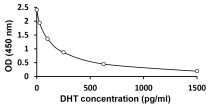ARG82998
Human Dihydrotestosterone / DHT ELISA Kit
Human Dihydrotestosterone / DHT ELISA Kit for ELISA and Human
Signaling Transduction kit
Overview
| Product Description | ARG82998 Human Dihydrotestosterone / DHT ELISA Kit is an enzyme immunoassay kit for the quantification of 5α-Dihydrotestosterone in human serum and plasma. |
|---|---|
| Tested Reactivity | Hu |
| Tested Application | ELISA |
| Target Name | Dihydrotestosterone / DHT |
| Conjugation | HRP |
| Conjugation Note | Substrate: TMB and read at 450 nm |
| Sensitivity | 5.944 pg/ml |
| Sample Type | Serum and plasma. |
| Standard Range | 25 - 1500 pg/ml |
| Sample Volume | 75 µl |
Application Instructions
| Assay Time | 60, 15 min |
|---|
Properties
| Form | 96 well |
|---|---|
| Storage Instruction | Store the kit at 2-8°C. Keep microplate wells sealed in a dry bag with desiccants. Do not expose test reagents to heat, sun or strong light during storage and usage. Please refer to the product user manual for detail temperatures of the components. |
| Note | For laboratory research only, not for drug, diagnostic or other use. |
Bioinformation
| Gene Full Name | Dihydrotestosterone (DHT) |
|---|---|
| Background | 5 alpha-dihydrotestosterone (DHT) is a steroid similar to testosterone and androstenedione, which belong to a class called androgens. DHT is a C19 steroid and possesses androgenic activity. The bulk of androgen production takes place mainly in the Leydig cells of the testes. Androgens circulate in the blood bound to proteins, especially sex hormone binding globulin (SHBG) and albumin. A trace amount of these steroids circulate in the unbound form in the blood and are referred to as the free fractions. DHT has at least three times the binding affinity for SHBG than testosterone. In males about 70% of DHT is derived from peripheral conversion of testosterone, while in females most of the DHT is derived from androstenedione. The major organ to neutralize androgens is the liver. Therefore in the liver the steroid hormones undergo structural modifications that are generally regarded as prerequisites for their biological inactivation. Some metabolites are formed and some are returned to the circulation before renal excretion. Therefore, elimination of steroids from the body is done through the urine. Clinical Trends: In Klinefelter's syndrome the DHT level is much lower than that found in normal men. In idiopathic hirsutism about 40% of the patients have an increased level of DHT. In polycystic ovaries (PCO) about 35% of the patients have an increased DHT level. The DHT level in young people is much higher than those found in normal older people, hence androgen production increases at puberty which gives rise to masculinizing characteristics. It has been demonstrated that the human testes produce DHT, which appears to originate in the seminiferous tubules. Therefore in tubular damage the production of DHT is impaired, which causes a decrease in the levels of plasma DHT (patients with germinal cell aplasia and azoospermia). There is a very low level of plasma DHT in patients with anorchia. It has been reported that in some prostate cancer (especially in stage D) the determination of DHT could be useful in predicting the response to anti-androgen therapy. |
| Highlight | Related products: Dihydrotestosterone antibodies; Dihydrotestosterone ELISA Kits; New ELISA data calculation tool: Simplify the ELISA analysis by GainData |
| Research Area | Signaling Transduction kit |
Images (1) Click the Picture to Zoom In






